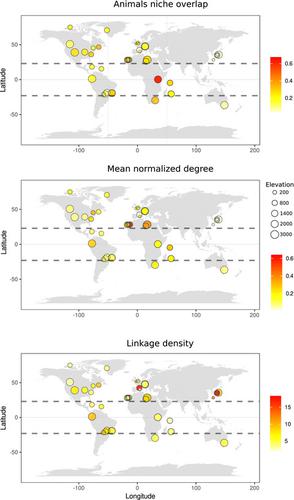当前位置:
X-MOL 学术
›
Ecol. Lett.
›
论文详情
Our official English website, www.x-mol.net, welcomes your
feedback! (Note: you will need to create a separate account there.)
Global trends in the trophic specialisation of flower-visitor networks are explained by current and historical climate
Ecology Letters ( IF 7.6 ) Pub Date : 2021-11-10 , DOI: 10.1111/ele.13910 Pedro Luna 1 , Fabricio Villalobos 2 , Federico Escobar 1 , Frederico S Neves 3 , Wesley Dáttilo 1
Ecology Letters ( IF 7.6 ) Pub Date : 2021-11-10 , DOI: 10.1111/ele.13910 Pedro Luna 1 , Fabricio Villalobos 2 , Federico Escobar 1 , Frederico S Neves 3 , Wesley Dáttilo 1
Affiliation

|
Trophic specialisation is known to vary across space, but the environmental factors explaining such variation remain elusive. Here we used a global dataset of flower-visitor networks to evaluate how trophic specialisation varies between latitudinal zones (tropical and temperate) and across elevation gradients, while considering the environmental variation inherent in these spatial gradients. Specifically, we assessed the role of current (i.e., net primary productivity, temperature, and precipitation) and historical (i.e., temperature and precipitation stability) environmental factors in structuring the trophic specialisation of floral visitors. Spatial variations in trophic specialisation were not explained by latitudinal zones or elevation. Moreover, regardless of network location on the spatial gradient, there was a tendency for higher trophic specialisation in sites with high productivity and precipitation, whereas historical temperature stability was related to lower trophic specialisation. We highlight that both energetic constraints in animal foraging imposed by climate and resource availability may drive the global variation in trophic specialisation.
中文翻译:

当前和历史气候解释了花卉访客网络营养专业化的全球趋势
众所周知,营养专业化会随着空间的变化而变化,但解释这种变化的环境因素仍然难以捉摸。在这里,我们使用花卉访客网络的全球数据集来评估营养专业化如何在纬度区域(热带和温带)和海拔梯度之间变化,同时考虑这些空间梯度中固有的环境变化。具体来说,我们评估了当前(即净初级生产力、温度和降水)和历史(即温度和降水稳定性)环境因素在构建花卉游客的营养专业化方面的作用。营养专业化的空间变化不能用纬度带或海拔来解释。此外,无论网络在空间梯度上的位置如何,在生产力和降水量高的地点存在较高营养专业化的趋势,而历史温度稳定性与较低营养专业化有关。我们强调,气候和资源可用性对动物觅食的能量限制可能会推动全球营养专业化的变化。
更新日期:2021-12-10
中文翻译:

当前和历史气候解释了花卉访客网络营养专业化的全球趋势
众所周知,营养专业化会随着空间的变化而变化,但解释这种变化的环境因素仍然难以捉摸。在这里,我们使用花卉访客网络的全球数据集来评估营养专业化如何在纬度区域(热带和温带)和海拔梯度之间变化,同时考虑这些空间梯度中固有的环境变化。具体来说,我们评估了当前(即净初级生产力、温度和降水)和历史(即温度和降水稳定性)环境因素在构建花卉游客的营养专业化方面的作用。营养专业化的空间变化不能用纬度带或海拔来解释。此外,无论网络在空间梯度上的位置如何,在生产力和降水量高的地点存在较高营养专业化的趋势,而历史温度稳定性与较低营养专业化有关。我们强调,气候和资源可用性对动物觅食的能量限制可能会推动全球营养专业化的变化。











































 京公网安备 11010802027423号
京公网安备 11010802027423号